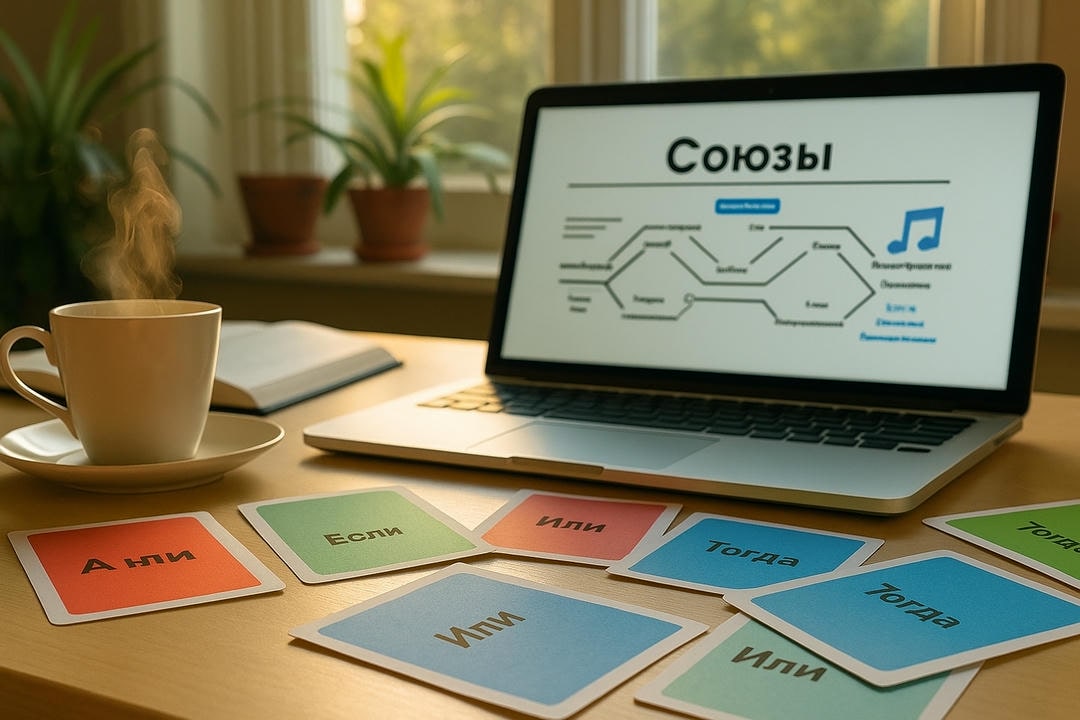Russian conjunctions serve as fundamental components in sentence structure, facilitating the connection of words, phrases, and clauses. They are categorized into coordinating and subordinating types, each with distinct functions that influence clarity and coherence. Understanding their usage is essential for constructing complex sentences. However, many learners encounter challenges that can impede effective communication. Exploring these intricacies reveals the significance of conjunctions in achieving nuanced expression within the Russian language.
Table of Contents
ToggleUnderstanding Conjunctions in Russian

In order to grasp the complexity of Russian grammar, one must first understand the role of conjunctions within the language. Conjunctions serve as critical connectors in sentence structure, facilitating coherence and logical flow. Their usage extends beyond mere conjunction, influencing the relationship between clauses and phrases.
For instance, the conjunction “и” (and) links similar ideas, while “но” (but) introduces contrast. Such conjunction examples illustrate how these linguistic tools shape meaning and enhance clarity. Additionally, effective conjunction usage allows speakers and writers to express nuanced thoughts with precision.
In a language where freedom of expression is paramount, mastering conjunctions is essential for articulating complex ideas and fostering understanding among diverse audiences.
Types of Russian Conjunctions
Understanding Russian conjunctions is essential for building complex, expressive sentences and improving reading comprehension. Conjunctions in Russian are called союзы (so-YOO-zɨ, meaning “conjunctions” or “unions”). These words and phrases connect different parts of a sentence or even entire sentences, helping ideas flow smoothly.
Coordinating Conjunctions (Сочинительные союзы)
Coordinating conjunctions in Russian connect words, phrases, or clauses that are of equal grammatical rank. The Russian term is сочинительные союзы (sa-chee-nee-TEL-ny-ye sa-YOO-zɨ).
Common coordinating conjunctions include:
- и (ee) – “and”
- или (EE-lee) – “or”
- но (noh) – “but”
- а (ah) – “and/but” (used to contrast)
- да (dah) – “and” (more formal or literary)
- зато (za-TOH) – “but, on the other hand”
For example, “Я читаю и пишу” (Ya chee-TAH-yu ee pee-SHOO) means “I read and write.”
Subordinating Conjunctions (Подчинительные союзы)
Subordinating conjunctions introduce a dependent (subordinate) clause, showing its relationship to the main (independent) clause. In Russian, these are подчинительные союзы (pod-chee-nee-TEL-ny-ye sa-YOO-zɨ).
Some common subordinating conjunctions:
- потому что (pa-ta-MOO shto) – “because”
- если (YES-lee) – “if”
- когда (kag-DAH) – “when”
- хотя (ha-TYA) – “although”
- чтобы (SHTO-by) – “in order to, so that”
- так как (tak kak) – “since, because”
For example, “Я останусь дома, потому что идёт дождь” (Ya as-TAH-noos’ DOH-ma pa-ta-MOO shto ee-DYOT dosht’) means “I will stay home because it is raining.”
Correlative Conjunctions (Парные союзы)
Correlative conjunctions are used in pairs to connect similar grammatical elements, emphasizing parallel structure and balance. In Russian, these are called парные союзы (PAR-ny-ye sa-YOO-zɨ).
Well-known examples include:
- и… и… (ee… ee…) – “both… and…”
- ни… ни… (nee… nee…) – “neither… nor…”
- то… то… (toh… toh…) – “either… or…” (sometimes expresses alternation)
- либо… либо… (LEE-ba… LEE-ba…) – “either… or…”
Example: “И мама, и папа пришли” (ee MA-ma, ee PA-pa preesh-LEE) means “Both mom and dad came.”
Conjunctive Adverbs (Союзные наречия)
Conjunctive adverbs act as a bridge between ideas, functioning both as adverbs and conjunctions. In Russian, these are often called союзные наречия (sa-YOOZ-ny-ye na-RYE-chee-ya).
Key examples include:
- однако (ad-NA-ka) – “however”
- поэтому (pa-EH-ta-moo) – “therefore”
- тогда (tag-DAH) – “then”
- значит (ZNA-chit) – “so, thus”
For example, “Было холодно, однако мы пошли гулять” (BEE-la HO-lad-na, ad-NA-ka my pa-SHLEE goo-LYAT’) means “It was cold; however, we went for a walk.”
Knowing how to use these different types of conjunctions (союзы) allows you to express cause and effect, contrast, choice, time relationships, and more. It also makes your Russian writing and speaking sound more natural and fluent.
Coordinating Conjunctions and Their Uses in Russian
Coordinating conjunctions are key to constructing clear and natural sentences in Russian. They connect words, phrases, or clauses of equal grammatical rank, making speech and writing more fluid and logical. These conjunctions help avoid unnecessary repetition and allow for concise expression of thoughts.
Main Coordinating Conjunctions
Below are the most common coordinating conjunctions in Russian, their usage, and examples:
1. И (and)
- Usage: Joins similar ideas or elements.
- Example:
- Он купил хлеб и молоко.
(On kupil khleb i moloko.)
He bought bread and milk.
- Он купил хлеб и молоко.
2. ИЛИ (or)
- Usage: Presents alternatives or choices.
- Example:
- Ты хочешь чай или кофе?
(Ty khochesh’ chai ili kofe?)
Do you want tea or coffee?
- Ты хочешь чай или кофе?
3. НО (but)
- Usage: Shows contrast or opposition between clauses.
- Example:
- Я хотел пойти, но было слишком поздно.
(Ya khotel poyti, no bylo slishkom pozdno.)
I wanted to go, but it was too late.
- Я хотел пойти, но было слишком поздно.
4. ДА (and/yet)
- Usage: Functions like “and” or “but” (less common in modern Russian, often found in literature).
- Example:
- День был холодный, да светлый.
(Den’ byl kholodnyy, da svetlyy.)
The day was cold yet bright.
- День был холодный, да светлый.
Additional Coordinating Conjunctions
While the above are the most frequent, here are a few other coordinating conjunctions:
- А (but/and) — contrasts two things, often softer than “но”.
- Example: Я люблю чай, а он любит кофе.
(Ya lyublyu chai, a on lyubit kofe.)
I like tea, and he likes coffee.
- Example: Я люблю чай, а он любит кофе.
- Зато (but/instead)
- Example: Я не умею готовить, зато хорошо пою.
(Ya ne umeyu gotovit’, zato khorosho poyu.)
I can’t cook, but I sing well.
- Example: Я не умею готовить, зато хорошо пою.
Common Russian Coordinating Conjunctions
| Cyrillic | Phonetic | English Definition |
|---|---|---|
| и | i | and |
| или | ili | or |
| но | no | but |
| да | da | and / yet |
| а | a | but / and (contrast) |
| зато | zato | but / instead |
Usage Tips
- Coordinating conjunctions never change form.
- They do not affect word order significantly; the connected items remain grammatically parallel.
- Overusing conjunctions can make sentences heavy; use them thoughtfully for clarity.
Understanding these conjunctions and their nuances is crucial for expressing yourself naturally in Russian. Practice by combining different types of words and clauses using the conjunctions above.
Subordinating Conjunctions: Connecting Ideas
Subordinating conjunctions in Russian are essential for creating complex sentences. Unlike coordinating conjunctions, which simply join two equal parts (like “and” or “but”), subordinating conjunctions connect a main clause with a dependent, or subordinate, clause. This relationship means the subordinate clause cannot stand alone—it depends on the main clause to make complete sense.
These conjunctions help express a wide range of ideas:
- Conditions: The conjunction “если” (yes-lee) means “if.” It’s used to introduce a condition or a possibility. For example:
- “Если будет дождь, мы останемся дома.” (yes-lee boo-det dozhd’, my ah-sta-nyem-sya doma)
Translation: “If it rains, we will stay home.”
- “Если будет дождь, мы останемся дома.” (yes-lee boo-det dozhd’, my ah-sta-nyem-sya doma)
- Reasons: “Поскольку” (pa-skohl-koo) or “потому что” (pa-ta-moo shto) both mean “since” or “because.” These words explain the reason for something.
- “Поскольку он устал, он рано лег спать.” (pa-skohl-koo on oo-stal, on rah-no lyok spat’)
Translation: “Since he was tired, he went to bed early.”
- “Поскольку он устал, он рано лег спать.” (pa-skohl-koo on oo-stal, on rah-no lyok spat’)
- Contrasts: “Хотя” (khat-YA) means “although” or “though.” It introduces a surprising contrast between two ideas.
- “Хотя было холодно, они гуляли.” (khat-YA by-lo kho-lad-na, a-nee goo-LYA-li)
Translation: “Although it was cold, they took a walk.”
- “Хотя было холодно, они гуляли.” (khat-YA by-lo kho-lad-na, a-nee goo-LYA-li)
- Time Relations: “Когда” (kag-DA) means “when.” It shows the time when something happens.
- “Я позвоню, когда приду домой.” (ya paz-va-NYU, kag-DA pree-DOO da-MOY)
Translation: “I will call when I get home.”
- “Я позвоню, когда приду домой.” (ya paz-va-NYU, kag-DA pree-DOO da-MOY)
Using these conjunctions allows Russian speakers to show cause and effect, explain reasons, introduce conditions, set up contrasts, and describe when things happen—all in one sentence. Mastering subordinating conjunctions helps you sound more natural and precise in Russian.
Other useful subordinating conjunctions include:
- Пока (pa-KA) – while, as long as
- Потому что (pa-ta-MOO shto) – because
- Чтобы (SHTO-by) – in order to/so that
- Перед тем как (pe-red tyem kak) – before
Learning how to use these connectors helps you express more complicated thoughts and connect your ideas smoothly. It opens up more expressive possibilities in your conversations and writing. The ability to weave main and subordinate clauses together is a key step toward fluency in Russian.
The Role of Conjunctions in Sentence Flow
Conjunctions are essential elements in Russian syntax, serving as linguistic bridges that connect words, phrases, and clauses within sentences. Their primary function is to ensure logical progression and cohesion, making texts easier to read and understand. Without conjunctions, written and spoken language would become fragmented, losing the natural rhythm that helps ideas flow smoothly from one to the next.
Russian utilizes both coordinating conjunctions (e.g., и “and”, но “but”, или “or”) and subordinating conjunctions (e.g., потому что “because”, если “if”, хотя “although”). Coordinating conjunctions link elements of equal syntactic importance, such as two independent clauses or items in a list. Subordinating conjunctions, on the other hand, introduce dependent clauses that provide additional context or detail to the main clause.
The placement of conjunctions in Russian is particularly important due to the relatively flexible word order of the language. Proper placement not only ensures grammatical correctness but also preserves the intended emphasis and rhythm of a sentence. For example, starting a sentence with a subordinating conjunction can set up expectations for a cause-and-effect relationship, while inserting a coordinating conjunction between two clauses creates balance and symmetry.
The choice of conjunction also subtly affects meaning. Using а instead of и can highlight contrast rather than simply adding information. Similarly, opting for чтобы (“in order to”) instead of и changes the relationship between actions from simple addition to purpose or intention.
Historically, Russian conjunctions have evolved from Old East Slavic, with some forms becoming archaic and new ones emerging. The variety and nuance of conjunctions allow Russian speakers and writers to craft sentences that are not only clear but also stylistically rich.
In summary, mastering conjunctions is crucial for anyone seeking to write or speak Russian fluently. They knit together ideas, clarify relationships between statements, and maintain the reader’s or listener’s engagement by ensuring smooth transitions. A skilled use of conjunctions reflects both linguistic competence and an understanding of how best to organize and express complex thoughts.
Common Mistakes When Using Russian Conjunctions

Mistakes in the use of Russian conjunctions can significantly disrupt communication and obscure the meaning of sentences. Russian, like English, relies on conjunctions (союзы) to link words, phrases, and clauses. However, due to differences in structure and logic, misuse is common among learners and even native speakers. Understanding how conjunctions work in Russian is essential to constructing clear, natural sentences.
Incorrect pairing of conjunctions is a frequent problem. Russian conjunctions such as “а” (but, while), “и” (and), “но” (but), and “или” (or) have specific functions. For example, “а” is often used to contrast two facts or situations, but it does not mean the same as “но”, which emphasizes opposition. Confusing these can change the intended relationship between clauses. For instance:
- Я люблю чай, а он кофе. (I like tea, while he likes coffee.)
- Я хотел пойти гулять, но пошёл дождь. (I wanted to go for a walk, but it started raining.)
Overusing “и” (and) is another common mistake. While “и” is straightforward, stringing together too many clauses with this conjunction can make sentences long-winded and difficult to follow—a hallmark of “run-on” sentences. Russian prefers more concise structures or a mix of conjunctions for better flow.
Punctuation plays a crucial role with coordinating conjunctions such as “а,” “но,” “или,” and “да” (and/but). Unlike English, Russian punctuation rules are stricter: commas are usually required before these conjunctions when they join independent clauses. Omitting these commas (запятые) can lead to misreading or confusion. For example:
- Я пошёл в магазин, но ничего не купил. (I went to the store, but bought nothing.)
Without the comma, the sentence can become ambiguous or lose its rhythm.
A subtle but important issue is the incorrect use of subordinating conjunctions (подчинительные союзы) such as “потому что” (because), “если” (if), “когда” (when), “чтобы” (in order to), and “так как” (since/as). These words indicate the relationship between main and subordinate clauses. Mixing them up or placing them incorrectly can distort the logical structure—making it unclear which information is primary and which is secondary. For example:
- Я остался дома, потому что шёл дождь. (I stayed home because it was raining.)
Using “и” instead of “потому что” here would not make sense.
Other points to watch for:
- Double conjunctions: In Russian, it’s generally incorrect to use two conjunctions together at the start of a clause (e.g., “И поэтому…”).
- False friends: Words like “также” (also) and “тоже” (too) are not conjunctions but adverbs; using them as connectors is a common error.
- Positioning: Some conjunctions must appear in specific locations within a sentence; misplacing them can make sentences sound awkward or even ungrammatical.
Key Russian conjunctions to be familiar with:
- и — and
- а — but/while
- но — but
- или — or
- да — and/but (depending on context)
- потому что — because
- если — if
- когда — when
- чтобы — in order to/so that
Mastering the proper use of Russian conjunctions requires attention to their meanings, the logical relationship between clauses, and correct punctuation. This careful approach helps convey ideas clearly and accurately in Russian.
Tips for Mastering Russian Conjunctions
Mastering Russian conjunctions is crucial for anyone looking to communicate effectively and express nuanced ideas in Russian. These small but powerful words—known as союзы (soyuzy)—link words, phrases, and clauses, shaping the structure and clarity of your speech and writing.
Understanding the three main types of conjunctions helps learners use them correctly:
- Coordinating Conjunctions (Сочинительные союзы)
These join elements of equal grammatical rank, such as words, phrases, or independent clauses. Common examples include:- и (i) – and
- но (no) – but
- или (ili) – or
- а (a) – but/and (contrastive)
- да (da) – and/but (literary or formal) For instance, “Я люблю чай и кофе” (I like tea and coffee) uses и to connect two nouns.
- Subordinating Conjunctions (Подчинительные союзы)
These introduce dependent clauses, indicating relationships such as cause, time, condition, or purpose. Key examples include:- потому что (potomu chto) – because
- когда (kogda) – when
- если (esli) – if
- чтобы (chtoby) – in order to/so that
- хотя (khotya) – although For example: “Я останусь дома, потому что идёт дождь” (I’ll stay home because it’s raining).
- Correlative Conjunctions (Парные союзы)
These work in pairs to connect similar sentence parts. Notable pairs include:- как… так и… (kak… tak i…) – both…and…
- не только… но и… (ne tol’ko… no i…) – not only… but also…
- если… то… (esli… to…) – if… then… Example: “Не только дети, но и взрослые любят мультфильмы” (Not only children, but also adults like cartoons).
Strategies for Mastery
- Categorize and memorize: Grouping conjunctions by type and function makes them easier to remember and apply.
- Practice in context: Use conjunctions in sentences, dialogues, and short texts to internalize their meanings. Practice both speaking and writing to develop comfort with different structures.
- Read authentic materials: Russian books, news articles, and conversations expose you to natural conjunction usage. Notice how writers and speakers link ideas—pay attention to subtle differences between similar conjunctions.
- Mind the nuances: Some Russian conjunctions have close English equivalents but can alter meaning depending on context. For example, а and но both mean “but,” but а often contrasts two statements without direct opposition, while но signals stronger contradiction.
- Review regularly: Consistent exposure and usage solidify understanding. Try rewriting simple sentences with different conjunctions to see how meaning changes.
Useful Russian Phrases and Keywords
- Союз (soyoz) – conjunction
- Сочинительный союз (sochinitel’nyy soyoz) – coordinating conjunction
- Подчинительный союз (podchinitel’nyy soyoz) – subordinating conjunction
- Парный союз (parnyy soyoz) – correlative conjunction
- Пример (primer) – example
By focusing on these aspects and actively engaging with real Russian texts, learners will gradually develop the ability to connect ideas naturally and express themselves with greater precision. Russian conjunctions are essential tools for building more complex, expressive sentences and achieving fluency.
The Art of Connection: Why Russian Conjunctions Matter
Mastering Russian conjunctions is more than just memorizing a list of linking words—it’s about understanding how meaning, nuance, and rhythm are woven into the fabric of the language. These seemingly simple words serve as the architecture that holds thoughts together, turning basic statements into expressive, complex ideas. By learning to distinguish between coordinating, subordinating, and correlative conjunctions—and using them with precision—you unlock the full expressive potential of Russian.
As you refine your grasp of conjunctions, you’ll notice how your sentences become richer, your arguments clearer, and your conversations smoother. The careful use of conjunctions not only helps you avoid common pitfalls but also gives your speech and writing a natural flow that resonates with native speakers. Ultimately, mastery of these connectors is a reflection of true linguistic competence; it transforms your Russian from functional to fluent, empowering you to communicate with clarity, sophistication, and authenticity.
![]()
Frequently Asked Questions
How Do Conjunctions Affect the Meaning of a Sentence?
Conjunctions greatly influence sentence meaning by integrating various conjunction types, thereby enhancing sentence complexity. Their strategic use enables nuanced relationships between ideas, allowing for clearer communication and greater freedom of expression within constructed sentences.
Can Conjunctions Change the Tone of a Sentence?
Conjunctions can indeed alter a sentence’s tone by introducing emotional emphasis and subtle nuances. Their careful selection allows for varied interpretations, influencing the overall mood and meaning conveyed, thereby enhancing the richness of communication.
Are There Regional Variations in Using Conjunctions?
Regional differences substantially influence conjunction usage, affecting syntax and semantics in diverse linguistic contexts. Variations in conjunction preferences and frequencies can reveal underlying cultural nuances, highlighting the intricate relationship between language and regional identity.
How Do Conjunctions Relate to Word Order in Russian?
Conjunction placement greatly influences word order in Russian. Coordinating conjunctions typically adhere to specific syntactic positions, impacting sentence flow and clarity. Understanding this relationship is essential for mastering nuanced expression and achieving communicative freedom within the language.
What Are Some Common Idiomatic Expressions Involving Conjunctions?
The analysis of idiomatic usage reveals various conjunction examples, such as “и” (and) and “но” (but), which enhance meaning and convey nuanced relationships in language, demonstrating their essential role in effective communication and expression.



